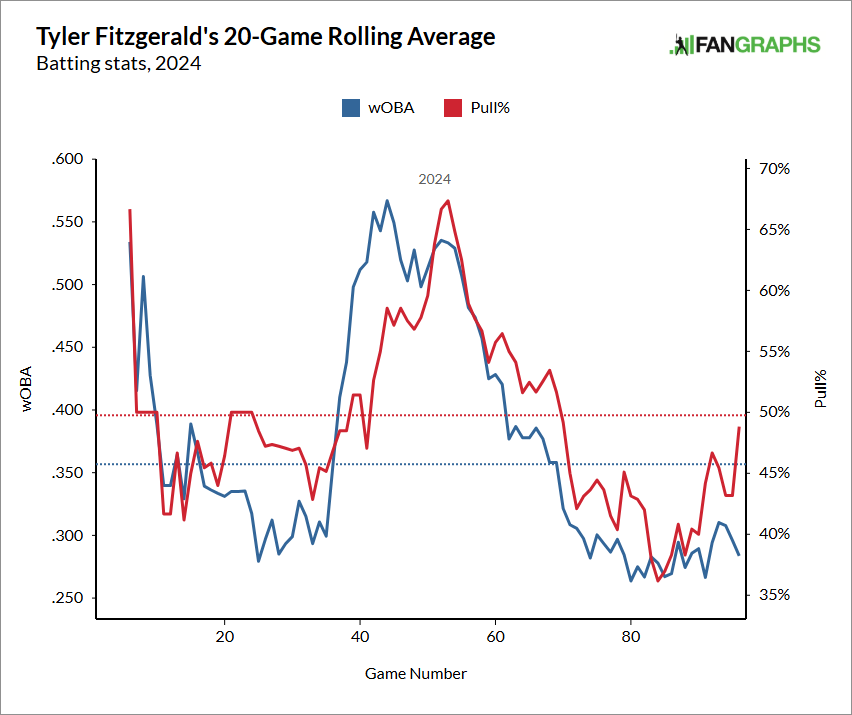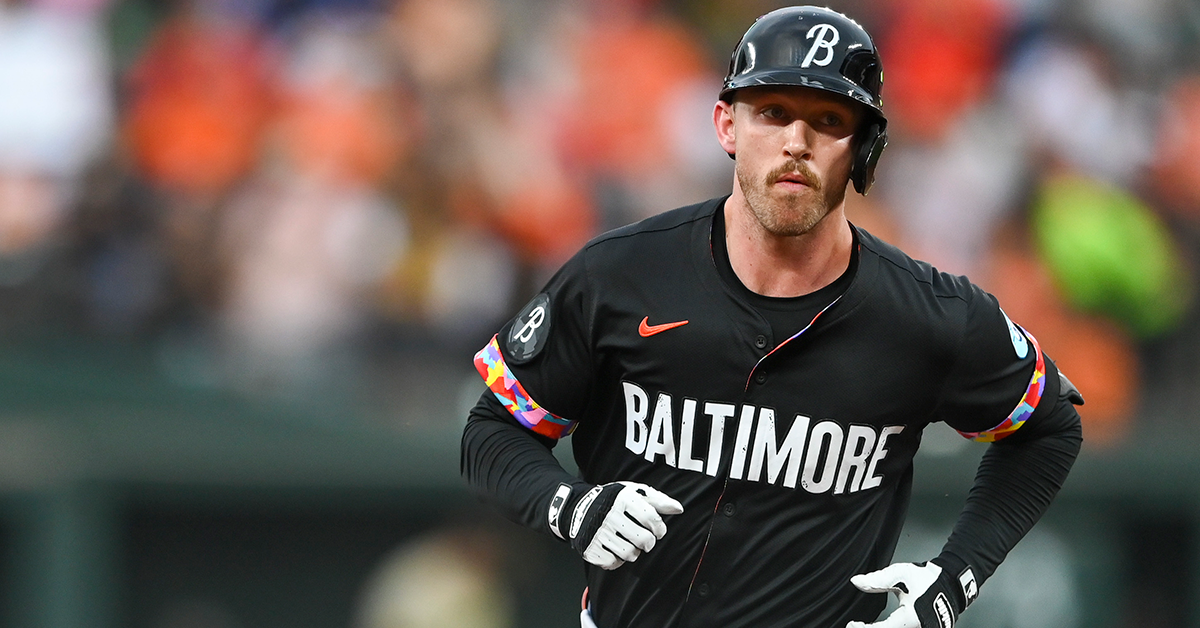Lucas started off this week with a look at tough keep or cut decisions at 2B and SS. Now it’s my turn with four guys on the keep/cut bubble.
–
Bo Bichette, SS
Salary: $28, $34
Average Salary: $29
2024 P/G: 3.04
Projected 2025 P/G: 5.31
I’m sure I’m not the only Ottoneu player wondering what the heck to do with Bo Bichette this offseason. His 2024 season was marred by multiple calf injuries and then cut short in the middle of September by a fractured finger. Even when he was on the field, he was horrendous, posting career worsts in WAR, wRC+, batting average, OBP, slugging percentage, wOBA, and xwOBA. It would be easy to chalk up his struggles to those injuries and expect a rebound season for him in 2025, but there were already some yellow flags in his profile before this year.
Bichette’s power output has been steadily declining year-over-year since peaking at a .260 ISO during his rookie year. His 2021 breakout now seems like a distant memory after settling in with a .348 wOBA across the two years afterwards. Despite all his injury issues this year, his hard hit rate stayed relatively stable even if his barrel rate collapsed. That tells me that he had no trouble making solid contact but his batted ball profile was all out of whack. Indeed, when we look at his rate of pulled elevated contact, 2024 represented a career low for him — just 19% of his elevated contact went to his pull side. His 29 home runs in 2021 notwithstanding, Bichette isn’t a traditional slugger but pulling the ball with authority is a surefire way to generate extra-base hits. Without that power, Bichette has produced a lot more empty batting average than you’d like to see, and that type of hitter just isn’t as valuable in Ottoneu than in traditional 5×5 leagues.
Steamer isn’t exactly bought in on a full bounce back either. It’s calling for a .330 wOBA which would have been a career low for him had 2024 not happened. My rankings aren’t sure what to do with him either as they currently show him in the mid-teens at shortstop in a tier with CJ Abrams and Xavier Edwards. That feels too low based on what he’s accomplished in the past but there are just so many question marks about what his product will look like in 2025.
Keep or cut?
I think $34 is too high a price with so much uncertainty surrounding him which makes him an easy cut in that league. $28 feels like it’s right on the cusp of the cut line too, but I think I’m up for gambling at that price. I could probably get him back in the draft somewhere around that price, but I’d rather hold on to him just for the roster clarity.
–
Brandon Lowe, 1B/2B
Salary: $13
Average Salary: $10
2024 P/G: 4.97
Projected 2025 P/G: 5.12
Oh look, another guy who feels tricky to evaluate due to injuries. Brandon Lowe’s injury history is much more extensive than Bichette’s, but to Lowe’s credit, he’s performed decently well when on the field. This year, he actually posted his best wRC+ since his monster season in 2021, and he only had one trip to the IL for an oblique strain towards the beginning of the season. Once he returned from that injury, he posted a scorching hot 152 wRC+ over the next three months, from May 20 through August 18. Afterwards, he fell into a bit of a slump and finished the season with an overall wRC+ of 123.
His batted ball peripherals all looked good; his hard hit and barrel rates all fell within his established norms and his power production was the best it’s been since 2021. There were some yellow flags in his plate discipline, however. His walk rate had sat at 11% over the last four years but fell to just 7.8% this year. His strikeout rate fell by about a point, which is good news, but the missing free passes are a lot more concerning. It all stems from an approach that was a lot more aggressive; his overall swing rate was a career high and was largely fueled by a five point jump in his zone swing rate. Swinging at more strikes is better than swinging at pitches outside the zone, but unless it comes with a corresponding jump in contact rate, it’s going to negatively affect his walk rate. That’s exactly what happened. He swung more often, didn’t make any more contact, and wound up walking and striking out less.
Of course, the real question for Lowe is how much he’ll end up playing in 2025. Between the injuries and the Rays careful handling of him against left-handed pitching, he’s accumulated more than 450 plate appearances in exactly one season during his career. On a per-plate-appearance basis, he’s one of the most productive second basemen out there, but rostering him means you’ll need to have a backup plan ready to go for 300 or so plate appearances.
Keep or cut?
His injuries and lack of playing time have depressed Lowe’s value these past few seasons, but he can really hit when he’s healthy. Still, $13 feels like it’s a bit too high to bet on a full season from Lowe. His average salary of $10 seems like a much better ceiling.
–
Tyler Fitzgerald, SS/OF
Salary: $4, $7
Average Salary: $8
2024 P/G: 5.06
Projected 2025 P/G: 4.46
An absolutely ridiculous month of July fueled Tyler Fitzgerald’s surprise breakout this year. Seriously, he hit .321/.390/.849 across 15 games that month and quickly took over the starting shortstop gig for a Giants team that was going nowhere. He continued to hit well through the end of the season and is slated to begin next season as the Giants starting second baseman after they signed Willy Adames.
He was ranked 26th on the Giants preseason prospect list as a 35+ FV prospect so his ascent and subsequent breakout were genuine surprises. Looking at all of his batted ball peripherals explains why no one really believes he’ll be able to replicate his success in 2025. He had below average exit velocity, hard hit rate, whiff rate, and xwOBA and his barrel rate was only slightly above average. His sweet spot rate was very high and his sprint speed was among the highest in baseball which could explain how he sustained such a high BABIP.
Fitzgerald’s entire approach is based on pulling the ball with authority; it’s the same kind of approach that Isaac Paredes uses with such great success. Indeed, look at how correlated Fizgerald’s pull rate is with his wOBA.

When he was crushing pitches to left field in July and August, he was a legitimate threat in San Francisco’s lineup. The issue is that this kind of approach is easily exploitable unless the batter has a good eye and can wait for the right pitch, like Paredes does. Unfortunately for Fitzgerald, he simply has too much swing-and-miss in his profile and isn’t patient enough to make his pull-happy ways work in the big leagues. My guess is that he’ll be a pretty streaky hitter in 2025, with some peaks like we saw this year, but an overall below average hitter.
Keep or cut?
Despite all the red flags laid out above, I’m not necessarily out on Fitzgerald at $4. He’ll add 2B back to his positional eligibility fairly quickly and a MI with his kind of potential for a hot streak is useful at that price. $7 feels like you’re paying for his July and August with the expectation that that hot streak is closer to his true talent and that’s just not going to be the reality.
–
Michael Massey, 2B
Salary: $3, $5
Average Salary: $4
2024 P/G: 3.98
Projected 2025 P/G: 4.51
I’m going to make this quick. Let’s play Chad’s favorite game: how many points did Michael Massey earn in games that he started? 4.64 points per game started! That’s a useful bench MI, and because he’s on the strong side of a platoon, it’s pretty easy to know when to lock him into your lineup or leave him on the bench. What’s funny is that even though the Royals protected him against left-handed pitching, Massey’s platoon split was just 4 points of wOBA.
Keep or cut?
I’m keeping at $3. At $5 things get a little dicey but it sounds like the Royals might be open to using Massey in the outfield now that they’ve acquired Jonathan India. Adding that positional flexibility might make him worth the extra couple of dollars.





